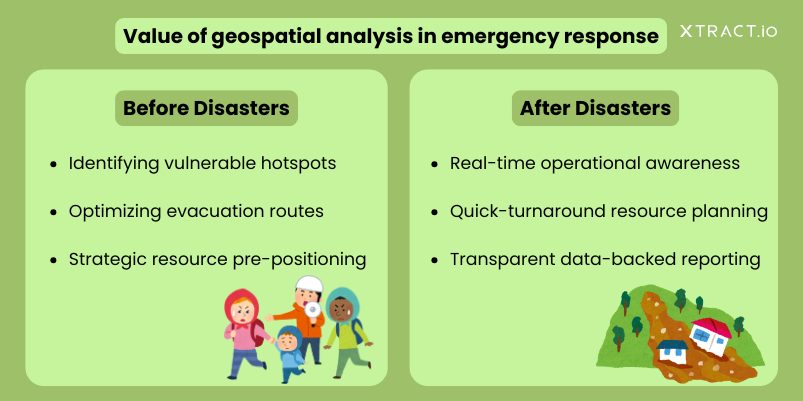Disaster management is one of the toughest challenges we face globally. But what if we take disaster preparedness seriously to avoid them, or at least face them with readiness? The recent Global Assessment Report 2025 (GAR 2025) from the UN Office for Disaster Risk Reduction (UNDRR) brings this into sharp focus. It’s a clear warning, showing us just how vulnerable we are and why we urgently need better ways to handle these events.
From the report,
- $313 billion is lost globally every year due to disasters, most of it with no budget in place and no insurance to help.
- Over 50% of countries face disasters large enough to put their national economies at serious risk.
- Climate change, rapid urbanization, and economic inequality are causing disasters to strike harder than before.
Not only that, the report also discusses that most disaster-related funding is used for emergency response and recovery, with much less invested in prevention and disaster preparedness. This imbalance puts communities in danger and slows down efforts to build lasting resilience. Responding to the urgent call from the UNDRR’s GAR2025 report, GIS engineers are reshaping how we anticipate, prepare for, and lessen the impact of disasters long before they happen.
The future of GIS is closely tied to advancements in geospatial analysis, for which geospatial data is the key. One geospatial data type that’s especially important in geospatial analysis is the point of interest, or POI data.
The goal of GIS engineers is not only to predict where disasters might occur but also to figure out what is most at risk and how best to respond. As an effort to innovate, GIS engineers use advanced technologies, like satellite imagery, remote sensing, real-time environmental data, and artificial intelligence, along with POI data to map risk with greater accuracy.
What is point of interest (POI) data in geospatial analysis?
POI data gives in-depth information about real-world places like hospitals, schools, fire stations, bridges, power lines, and even water treatment plants. It doesn’t just show where these places are on a map. It also includes helpful POI attributes, like what the place is used for, how big it is, and how it might be impacted during a disaster.
This kind of data is used by GIS engineers for geospatial analysis. It helps them get insights about what’s at risk in a specific area. Not only that, but it also helps to make decisions when it comes to planning, emergency response, or infrastructure upgrades. But the quality of insights depends on the quality of your POI data, so choosing the right POI provider is important. Now, let’s understand how POI is helping with geospatial analysis in emergency response.
The strategic value of geospatial analysis in emergency response
To make it easier to understand, let’s break it down into two parts. One, what geospatial analysis does before a disaster, and two, how it helps after one hits. Here’s how it works in both emergency response situations.

1. Before Disasters
This phase sets the stage, as geospatial analysis gives the insights we need to be proactive.
Identifying vulnerable hotspots
Geospatial analysis pinpoints high-risk neighborhoods for floods, wildfires, or earthquakes by layering data like elevation, weather patterns, building codes, and population density onto maps, often visualized as heatmaps that clearly show danger zones. This clear risk picture guides emergency managers to focus resources efficiently.
Also, POI (Point of Interest) data shows vital locations like hospitals, schools, and infrastructure. It adds a crucial layer, revealing what is at risk. This combination empowers planners to prioritize protection, make better decisions, and pre-deploy resources effectively, all before disaster strikes.
Optimizing evacuation routes
Planning for evacuation is crucial when a disaster strikes. Geospatial analysis enables the design of the safest and most efficient escape routes by mapping POI data. This helps to identify road networks, potential bottlenecks, and real-time traffic data.
Geospatial intelligence spots potential trouble spots like bridges, tunnels, or areas prone to flooding that could slow things down during an evacuation. Plus, this kind of analysis helps ensure that vulnerable groups, like the elderly or people with disabilities, can evacuate safely. And since disasters can change quickly, having real-time POI data gives the ability to adjust routes on the fly, which is a crucial part of staying one step ahead.
Strategic resource pre-positioning
Where should emergency supplies, medical teams, and equipment be stored so they can be deployed most effectively when disaster strikes? Understanding probable impact zones and logistical constraints can strategically place aid caches, mobile hospitals, and staging areas.
This means faster access to vital resources for affected communities, reducing delays that can be life-threatening.
2. After disasters
This phase is all about quick action and smart recovery. Geospatial analysis helps emergency teams see what’s been damaged, where help is needed most, and how to coordinate resources.
Real-time operational awareness
When paired with live satellite feeds and mobile sensors, geospatial analysis becomes an operational map. Also, with POI data, emergency teams can instantly identify which facilities are still functional, which roads are blocked, and where people are likely to gather. POI data fills the information gap that first responders frequently face in chaotic situations.
Resource optimization under pressure
Geospatial data solutions, combined with POI attributes, help dispatch teams to the most critical or densely populated locations first. This triage is not just based on need but also on acting where it matters most.
During a disaster, a bridge might collapse. Even if it may seem like just one damaged part, if it connects several key POIs like a hospital or an evacuation shelter, then restoring that bridge becomes a top priority. This kind of insight from geospatial intelligence and POI data helps responders see beyond the surface and make decisions that keep whole systems running.
Transparent and data-backed reporting
POI data supports citizens, government, and donors in making funding decisions as it builds public trust. Nowadays, more and more people want to see where help is going and what’s getting done. POI maps and impact assessments give transparent evidence of what was affected, what actions were taken, and what still needs to be done.
Also, POI data encourages collaboration among agencies, NGOs, and local communities by creating a shared understanding of needs and priorities. For example, during a disaster recovery phase, seeing which schools or hospitals have been restored and which are still non-functional can help align relief efforts and avoid resource gaps.
Final thoughts
POI data is a strategic asset, as it enriches geospatial analysis and becomes the foundation for disaster intelligence. In the hands of GIS engineers, it turns static geospatial intelligence into a living, adaptive system for saving lives, protecting economies, and strengthening resilience.
If you are looking for POI data, Xtract.io provides detailed, up-to-date POI data that helps emergency teams act quickly and make better decisions when it matters most.
Want to learn more? Reach out to us to explore how geospatial data solutions can support your emergency response initiatives.

